Emerging Consumer Experience Trends in 2025’s Digital World

Digital transformation is reshaping how you interact with brands, creating new benchmarks for customer experience. Today, 84% of customers value their experience with a company as much as its products. By 2025, 85% of customer interactions will rely on AI instead of human agents. This shift reflects how your expectations for faster, personalized, and seamless services are growing. The market for digital transformation is also booming, forecasted to reach $2116.91 billion that same year. Companies like Sobot are leading this change, delivering intelligent solutions that align with emerging consumer experience trends to meet these evolving demands.
The Role of Digital Transformation in Consumer Experience Trends
Defining Digital Transformation in 2025
Digital transformation in 2025 represents the integration of advanced technologies into business processes to meet evolving consumer expectations. It goes beyond adopting digital tools. It involves creating a seamless digital experience that aligns with your needs. Companies are leveraging AI, machine learning, IoT, and cloud computing to redefine how they operate and interact with customers. This transformation focuses on enhancing efficiency, driving innovation, and delivering personalized experiences.
Metrics play a crucial role in quantifying the success of digital transformation strategies. Businesses measure customer happiness, operational efficiency, and employee productivity to evaluate their progress. For example, Net Promoter Scores (NPS) and churn rates reflect how well companies improve customer experience. Operational metrics like reduced error rates and faster cycle times highlight efficiency gains. The table below outlines key metrics used to define digital transformation in 2025:
| Metric Type | Description |
|---|---|
| Customer Experience Metrics | Measures indicators like customer happiness index, Net Promoter Score, churn, and self-service adoption. |
| Operational Efficiency | Includes metrics such as speed-up in cycle times, reduction in error rates, and effective resource allocation. |
| Employee Productivity | Evaluates efficiency through indices like time saved and task completion ratio. |
| Return on Digital Investments | Insight into profitability and value creation from digital activities. |
| Adoption & Performance Metrics | Monitors user adoption rates and system usage to assess digital tool acceptance. |
| Revenue from Digital Technology | Tracks revenue generated from digital technology implementations. |
| Percentage of Cloud Deployments | Measures the extent of cloud adoption in the organization. |
| Active Usage Metrics | Tracks user engagement rates and frequency of digital solution usage. |
| Innovation Impact Metrics | Evaluates the effectiveness of digital transformation in boosting innovation. |
| Data Utilization Effectiveness | Assesses how well data assets are converted into business value. |
These metrics provide insights into how businesses adapt their strategies to stay competitive in a rapidly changing digital landscape.
How Digital Transformation Enhances Customer Experience
Digital transformation revolutionizes customer experience by enabling businesses to deliver faster, more personalized, and seamless interactions. AI-powered tools, such as chatbots and virtual assistants, allow you to access support 24/7 without waiting for human agents. Companies use data-enabled customer insights to anticipate your needs and offer tailored solutions. This approach not only meets your expectations but also exceeds them.
For instance, digitally mature companies report a 20-30% increase in customer satisfaction when they prioritize customer experience. The impact of digital transformation extends beyond satisfaction. It drives profitability, with digitally advanced firms being 23% more profitable than their peers. The chart below illustrates key outcomes of digital transformation:
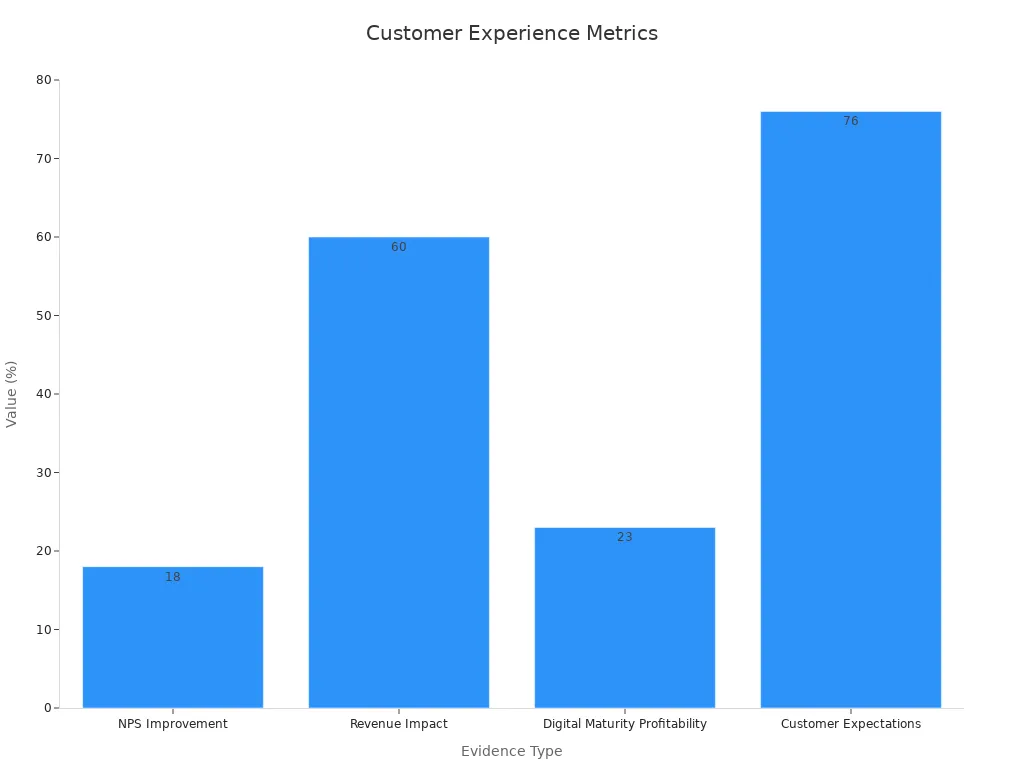
Several companies have successfully implemented digital transformation strategies to enhance customer experience. The table below highlights their achievements:
| Company | Impact of Digital Transformation | Key Outcomes |
|---|---|---|
| Walmart | Enhanced customer convenience through digital technologies. | Increased online and in-store sales, strengthened market position, improved customer loyalty. |
| Siemens | Adoption of digital twin technology and IoT for industrial automation. | Decreased time to market, reduced operational costs, improved product quality and innovation. |
| Toyota | Improved vehicle functionality and safety through connected technologies. | Increased customer satisfaction and loyalty, positioned as a leader in mobility solutions. |
| Unilever | Digital sustainability and supply chain management initiatives. | Improved operational efficiencies, reduced environmental footprint, strengthened brand reputation. |
| Delta | Enhanced customer experience and operational efficiencies in the airline industry. | Improved customer satisfaction, solidified reputation as an innovator. |
| Nike | Shifted sales strategy towards direct-to-consumer through digital focus. | Increased brand loyalty, valuable customer data for future strategies. |
| Coca-Cola | Enhanced consumer engagement through advanced analytics and digital marketing. | Increased brand visibility, more personalized marketing campaigns. |
These examples demonstrate how digital transformation strategies improve customer experience while driving business growth. By adopting these strategies, companies can meet your expectations and deliver exceptional service.
Hyper-Personalization in the Digital Era
AI and Data Analytics Driving Tailored Experiences
Hyper-personalization has become a cornerstone of digital transformation, allowing businesses to deliver experiences that feel uniquely tailored to you. AI and data analytics play a pivotal role in this transformation. By analyzing vast amounts of customer data, businesses can predict your preferences, anticipate your needs, and offer solutions that resonate with you on a personal level.
For example, predictive analytics enables companies to improve customer retention rates by 25% and boost engagement levels by 30%. Metrics like response times and satisfaction scores also see significant improvements, with reductions in churn rates reaching up to 20%. Companies like Grove Collaborative use AI insights to refine their personalized services, while Motel Rocks leverages sentiment analysis to enhance customer experience efficiency.
The impact of hyper-personalization is evident across industries. Starbucks creates 400,000 unique email variants weekly, offering personalized app promotions that strengthen customer loyalty. McKinsey reports that businesses adopting hyper-personalization see a revenue lift of 10-15%, demonstrating its effectiveness in driving growth. The table below highlights additional industry examples:
| Company | Evidence | Impact on Customer Experience |
|---|---|---|
| Starbucks | Created 400,000 email variants per week, personalized app offers. | Improved customer engagement and loyalty. |
| McKinsey | Reports a revenue lift of 10-15% on average due to hyper-personalization. | Enhanced marketing efficiency and sales growth. |
| General | Companies excelling at personalization generate 40% more revenue. | Demonstrates the effectiveness of personalized interactions. |
As expectations for immediate service rise, businesses must adapt. A staggering 72% of customers now expect instant responses, underscoring the importance of AI-driven personalization. Sephora, for instance, has increased customer engagement by 30% through tailored experiences, while AI personalization boosts redemption rates by 35%. These statistics highlight how hyper-personalization transforms customer engagement into a competitive advantage.
Sobot Chatbot’s Role in Personalized Customer Interactions
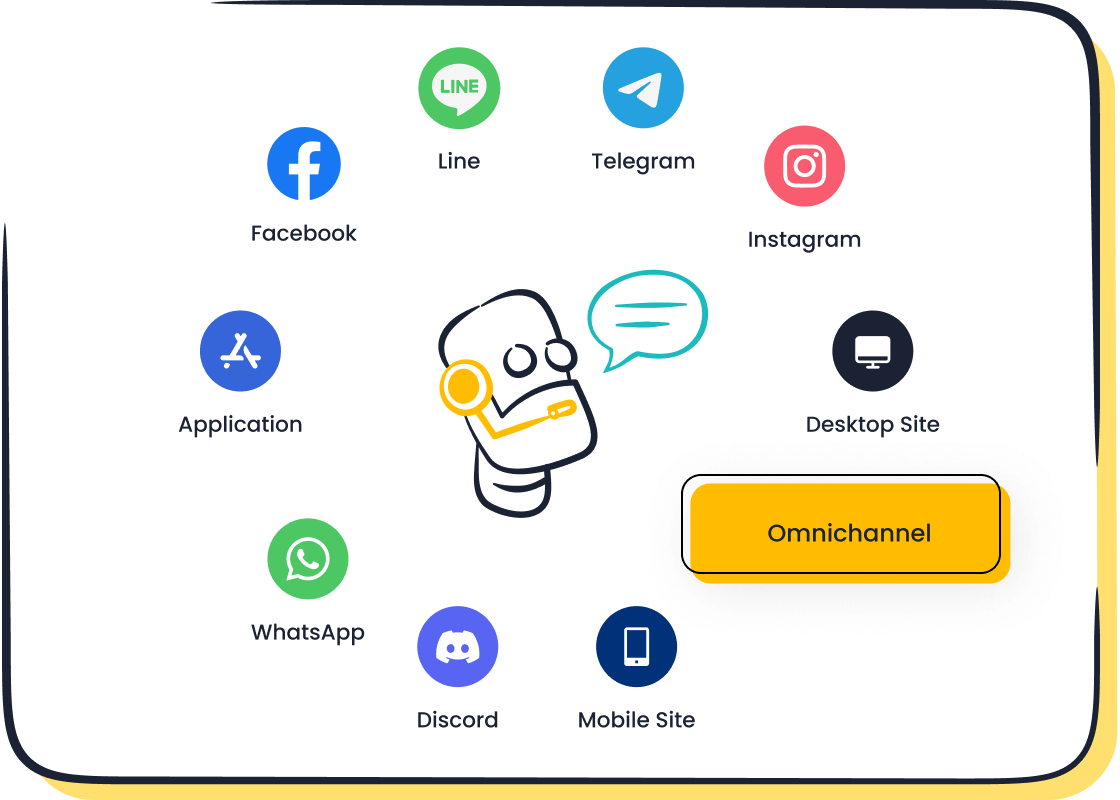
Sobot’s AI Chatbot exemplifies how hyper-personalization can redefine customer experience. Designed to operate 24/7, the chatbot uses advanced AI and data analytics to deliver personalized interactions across multiple channels. It doesn’t just answer your queries; it anticipates your needs and provides solutions tailored to your preferences.
The chatbot’s multilingual capabilities ensure seamless communication, regardless of your language. Its omnichannel support allows you to interact through platforms like WhatsApp, SMS, and live chat, creating a unified experience. By leveraging a knowledge base built from articles, PDFs, and other sources, the chatbot delivers accurate responses instantly, saving you time and effort.
Businesses benefit significantly from Sobot’s chatbot. It improves productivity by 70%, reduces service costs by up to 50%, and boosts conversions by 20%. For example, Samsung integrated Sobot’s chatbot into its customer service operations, achieving a 97% satisfaction rate and increasing agent efficiency by 30%. This success demonstrates how AI-powered tools like Sobot’s chatbot enhance customer engagement and loyalty.
The chatbot’s proactive messaging and real-time intent assistance further elevate the customer experience. Whether you’re browsing products or seeking support, the chatbot ensures you receive a hyper-personalized experience that meets your expectations. With Sobot’s solutions, businesses can transform customer interactions into meaningful connections, driving satisfaction and growth.
Omnichannel Integration for Seamless Customer Journeys

Bridging Digital and Physical Channels
In 2025, the line between digital and physical shopping experiences continues to blur. Consumers now expect a seamless transition between these channels, creating a unified customer journey. For instance, 64% of consumers anticipate smooth movement between online and in-store interactions, while 72% feel frustrated when businesses treat these as separate experiences. This shift highlights the importance of integrating digital transformation into every touchpoint of the customer experience.
Omnichannel strategies like buy-online-pick-up-in-store (BOPIS) have gained immense popularity. Flexible fulfillment options, such as BOPIS, have grown by 28% year-over-year since 2020, with 83% of consumers expecting such services. Businesses excelling in omnichannel execution report a 23% increase in customer satisfaction and a 15% boost in customer lifetime value. These figures underscore the value of creating a multi-channel experience that caters to modern consumer expectations.
Companies that bridge digital and physical channels effectively see tangible benefits. Omnichannel customers spend 4% more in-store and 10% more online compared to single-channel shoppers. By aligning digital transformation with customer needs, businesses can enhance loyalty and drive revenue growth. This approach ensures that every interaction, whether online or offline, contributes to a cohesive and satisfying customer journey.
Sobot’s Solutions for Unified Customer Contact
Sobot’s all-in-one contact center solutions empower businesses to deliver a seamless multi-channel experience. By integrating communication channels like live chat, voice, email, and social media into a single platform, Sobot ensures that your customer interactions remain consistent and efficient. This unified approach eliminates the frustration of switching between systems, creating a smoother customer journey.
The performance metrics of Sobot’s solutions validate their effectiveness. With a 97% customer satisfaction score, over 80% correct answers rate, and an 85% problem resolution rate, Sobot demonstrates its ability to enhance the customer experience. For example, Samsung leveraged Sobot’s platform to unify its communication channels, achieving a 30% increase in agent efficiency and a 97% satisfaction rate. These results highlight how Sobot’s solutions align with the demands of digital transformation.
Sobot’s omnichannel capabilities also cater to the growing need for personalization. By connecting customer data across channels, Sobot enables businesses to anticipate needs and deliver tailored experiences. This approach not only improves customer satisfaction but also strengthens loyalty, ensuring that every interaction feels meaningful and connected.
Immersive Technologies Transforming Consumer Engagement
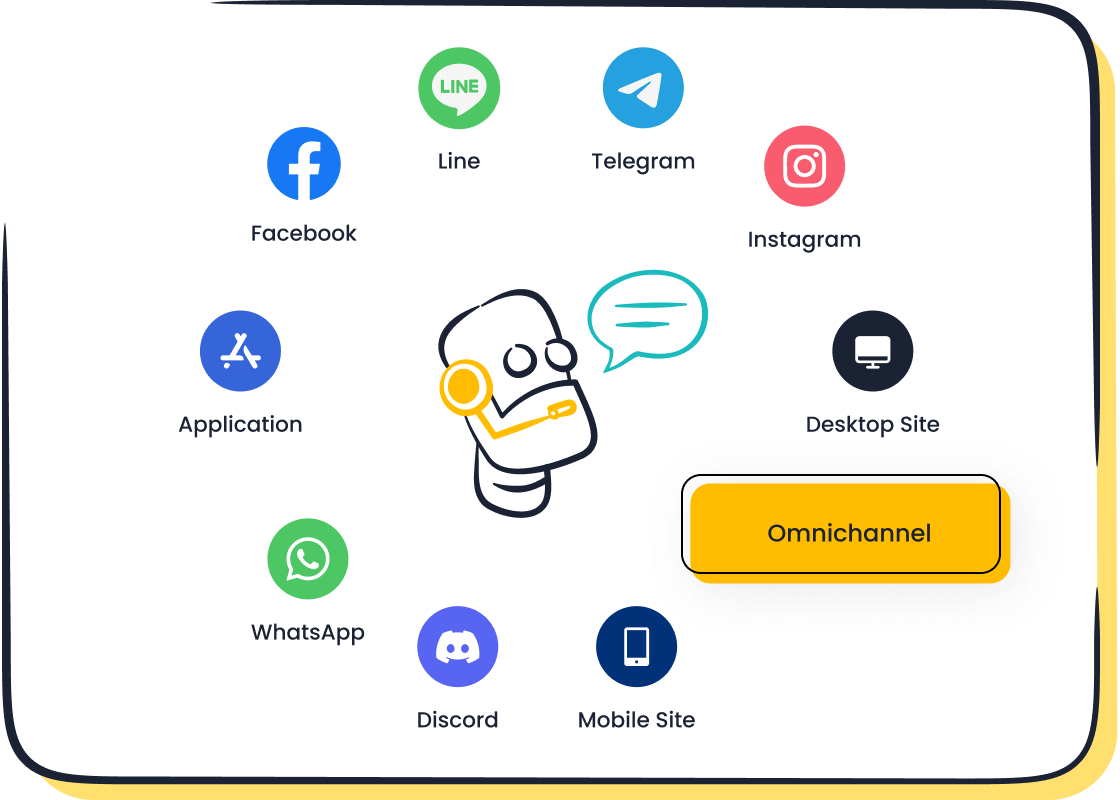
AR, VR, and the Metaverse in Customer Experience
Immersive technologies like augmented reality (AR), virtual reality (VR), and the metaverse are revolutionizing how you interact with brands. These tools create engaging experiences that feel personal and interactive. For example, AR allows you to visualize products in your space before purchasing, while VR transports you to virtual environments where you can explore services or attend events. The metaverse combines these technologies, offering a shared digital space where you can connect with brands and other users.
The adoption of these technologies is growing rapidly. Over 60% of VR headset usage now ties to metaverse applications. By 2026, 75% of global brands are expected to use AR and VR for marketing. These tools also drive significant business outcomes. AR applications in retail are projected to influence $120 billion in sales by 2026. The chart below highlights the adoption rates and revenue impact of AR and VR:
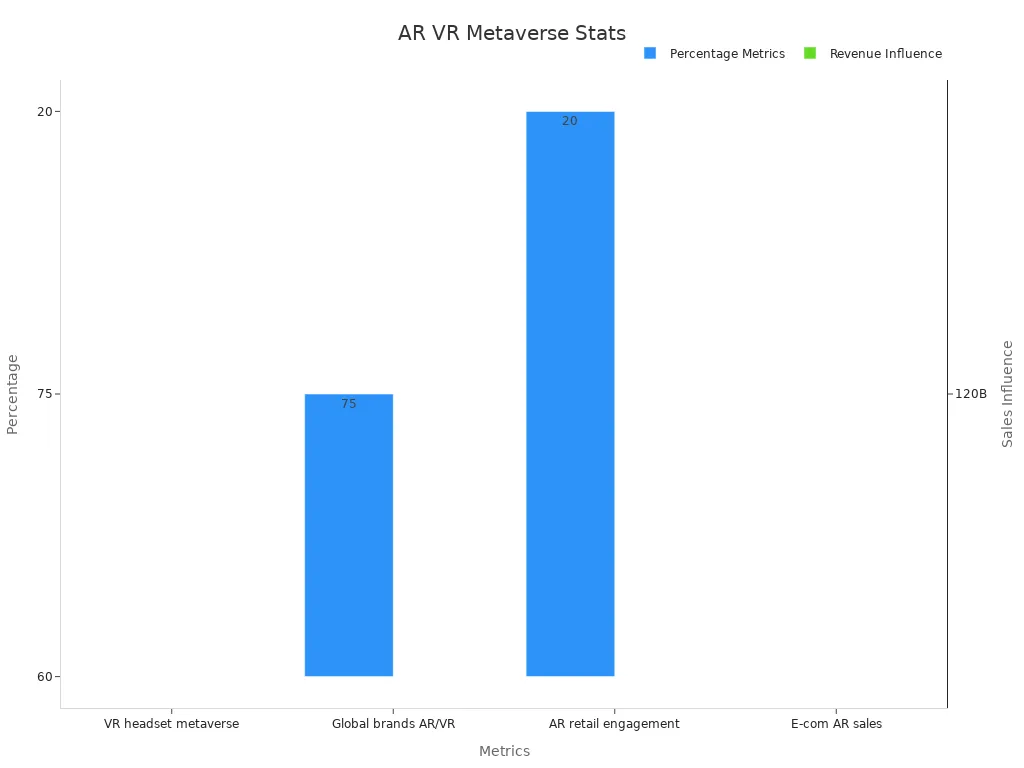
When brands use immersive technologies, they can boost conversion rates by 90% or more for certain products. This transformation aligns with your expectations for personalized interactions, which 71% of customers now demand. These tools make it possible to experience products and services in ways that were unimaginable just a few years ago.
Applications in Virtual Shopping and Events
Virtual shopping and events are redefining how you engage with brands. Imagine trying on clothes virtually or attending a product launch from the comfort of your home. These experiences are powered by immersive technologies, making them accessible and engaging. Virtual shopping lets you explore products in detail, while virtual events connect you with brands and communities in interactive ways.
Brands measure the success of these applications through metrics like Net Promoter Scores (NPS) and attendee-to-sales-qualified-lead (SQL) conversions. High NPS scores reflect your satisfaction, while SQL conversions show how many attendees are interested in purchasing products. Post-event surveys and on-demand content engagement also provide valuable insights into how these experiences resonate with you.
Virtual events generate tangible results. They drive revenue, strengthen customer loyalty, and create memorable experiences. For example, on-demand content often receives high viewer numbers and positive feedback, showing its effectiveness in keeping you engaged. These applications demonstrate how immersive technologies transform digital interactions into meaningful connections.
Ethical and Sustainable Consumerism in 2025
Transparency and Traceability Through Digital Tools
In 2025, transparency and traceability have become essential to meeting changing customer expectations. You want to know where products come from, how they are made, and whether they align with your values. Digital transformation plays a key role in providing this visibility. Tools like blockchain and IoT enable businesses to track product origins and share this information with you in real time. This level of transparency builds trust and enhances customer satisfaction.
The adoption of traceability solutions is growing rapidly. Over 75% of manufacturing companies plan to implement these systems, and large enterprises are expected to achieve 60% adoption by 2025. These tools improve efficiency by 20% and reduce supply chain disruptions by 30%. The table below highlights additional benefits of traceability:
| Statistic | Value |
|---|---|
| Savings in recall costs over the last five years | Approximately $1 billion |
| Projected CAGR of the global traceability market from 2021 to 2026 | 15.8% |
| Percentage of organizations researching or implementing blockchain solutions | 55% |
| Predicted market value of blockchain technology in supply chain by 2023 | USD 3,314.6 million |
These advancements not only meet customer demands but also help businesses avoid costly recalls and disruptions. By leveraging digital tools, companies can ensure their operations align with your expectations for ethical and sustainable practices.
Aligning Brand Values with Consumer Expectations
You expect brands to reflect your values, especially when it comes to sustainability and ethics. In 2025, this alignment is more critical than ever. Customers quickly switch brands when their values aren’t represented. Transparent sourcing and production practices are now non-negotiable. You want to see tangible actions, not just marketing promises.
Digital transformation helps brands meet these expectations. By using AI and data analytics, companies can identify gaps in their practices and make meaningful changes. For example, businesses that adopt sustainable strategies see a 71% faster growth rate in the eco-friendly retail market compared to conventional methods. The chart below illustrates the growing trend toward ethical consumerism:
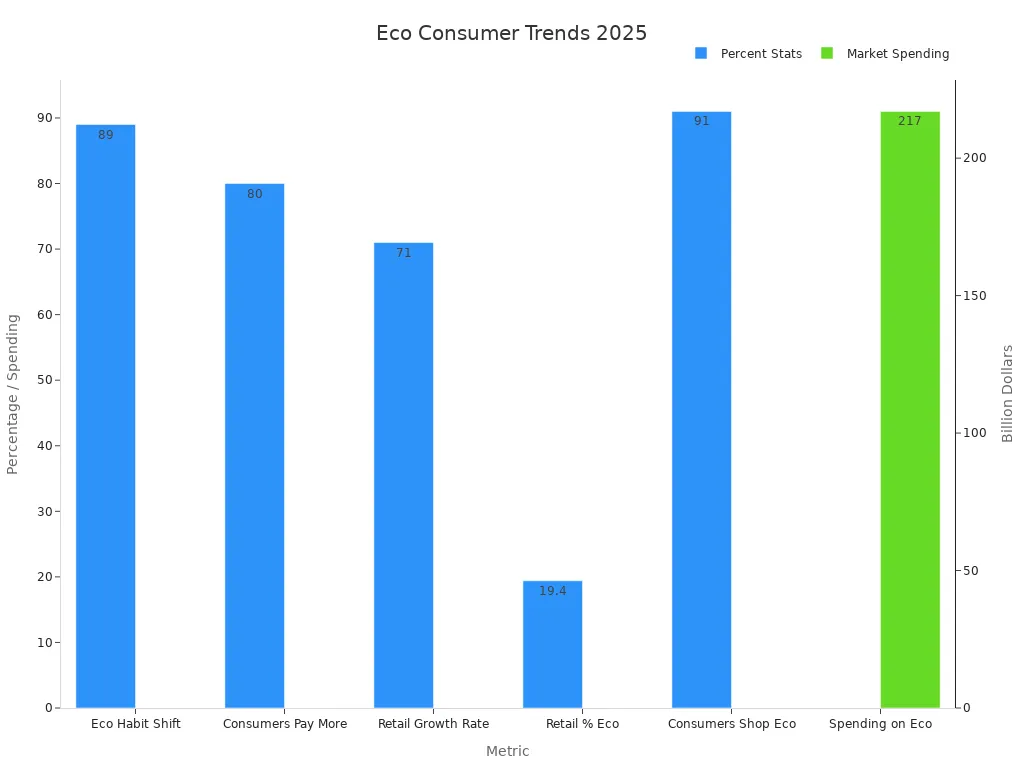
You also expect brands to take a stand on issues like climate action and community-building. Companies that align with these values not only improve customer satisfaction but also strengthen loyalty. In 2025, 91% of consumers are expected to shop eco-friendly, contributing to an estimated $217 billion in spending on sustainable products. This shift highlights the importance of aligning brand values with customer demands to create meaningful connections and drive satisfaction.
Challenges and Opportunities in Digital Transformation
Overcoming Barriers to Adoption
Digital transformation offers immense potential, but you may encounter challenges when adopting it. Many businesses struggle with modernizing customer touchpoints or enabling the right infrastructure. A survey revealed that 54% of companies focus on improving customer touchpoints, while 45% prioritize infrastructure upgrades. However, 41% fail to conduct thorough customer research before investing in transformation efforts. This lack of preparation often leads to missed opportunities.
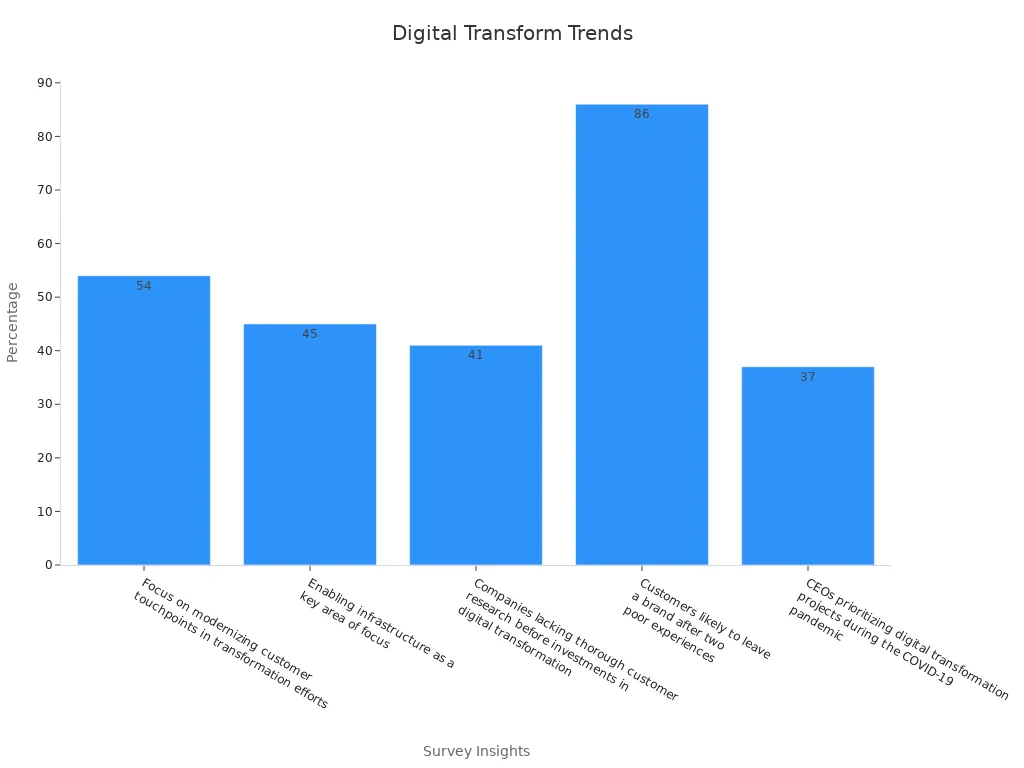
Another significant barrier is customer retention. Research shows that 86% of customers leave a brand after two poor experiences. This statistic highlights the importance of delivering consistent, high-quality customer experiences. Nearly 50% of companies cite improving customer experience as the primary reason for starting their transformation journey. To overcome these barriers, you need to focus on customer-centric strategies and invest in technologies that enhance interactions.
Leadership support also plays a crucial role. During the COVID-19 pandemic, 37% of CEOs prioritized digital transformation projects. Strong leadership ensures that transformation initiatives align with your goals and deliver measurable results. By addressing these challenges, you can unlock the full potential of digital transformation.
Leveraging Sobot’s AI Solutions for Competitive Advantage
Sobot’s AI solutions empower you to overcome these challenges and gain a competitive edge. By integrating advanced AI tools, Sobot enhances customer interactions and streamlines operations. For example, its AI Chatbot reduces waiting times by 35%, making your experience faster and more efficient. It also improves engagement by creating 40% more interactive touchpoints, ensuring every interaction feels meaningful.
| Metric Description | Performance Improvement |
|---|---|
| Decrease in waiting times | 35% |
| Enhancement in customer interactions | 60% of clients benefited |
| Increase in user engagement | 40% more interactive touchpoints |
Sobot’s omnichannel capabilities allow you to connect with brands across multiple platforms seamlessly. Whether you prefer live chat, voice, or social media, Sobot ensures a unified experience. This approach not only improves customer satisfaction but also strengthens loyalty. Businesses using Sobot’s solutions report a 60% improvement in customer interactions, demonstrating the platform’s effectiveness.
By leveraging Sobot’s AI solutions, you can transform your customer experience and stay ahead in a competitive market. These tools help you address challenges, meet evolving expectations, and deliver exceptional service.
Digital transformation drives the evolution of consumer experience trends in 2025. It empowers businesses to deliver faster, more personalized, and seamless interactions. Metrics like customer satisfaction scores and net promoter scores highlight its impact. AI-driven strategies analyze behavioral data to enhance engagement, while hyper-personalization creates tailored experiences that resonate with you. Tools like Sobot’s Chatbot and AI solutions help businesses adapt to these trends. They unify communication channels, improve efficiency, and ensure every interaction feels meaningful. By embracing these innovations, businesses can meet your expectations and stay competitive in a rapidly changing digital world.
FAQ
1. What is digital transformation, and why does it matter to you?
Digital transformation integrates advanced technologies into business processes to improve customer experiences. It matters because it makes your interactions faster, more personalized, and seamless. Companies use tools like AI and data analytics to meet your expectations and deliver exceptional service.
2. How does Sobot’s AI Chatbot improve customer interactions?
Sobot’s AI Chatbot operates 24/7, providing instant responses tailored to your needs. It supports multiple languages and channels like WhatsApp and SMS. By automating repetitive tasks, it saves time and ensures you receive accurate, personalized assistance.
3. Why is hyper-personalization important for your experience?
Hyper-personalization uses AI and data analytics to create experiences that feel unique to you. It anticipates your preferences and offers tailored solutions. This approach improves satisfaction, strengthens loyalty, and helps businesses meet your expectations for immediate, meaningful interactions.
4. How does omnichannel integration benefit you as a customer?
Omnichannel integration connects all communication channels into one seamless system. It ensures you can switch between platforms, like live chat and social media, without losing context. This unified experience saves time and makes your interactions smoother and more enjoyable.
5. What role do immersive technologies play in your shopping experience?
Immersive technologies like AR and VR let you explore products virtually before buying. They make shopping interactive and engaging. For example, you can try on clothes or visualize furniture in your space, enhancing your confidence in purchasing decisions.
See Also
Discovering Leading Cloud Contact Centers for 2025
Best Reviews of Cloud Contact Center Services for 2024
Evaluating Leading Contact Center Solutions for 2024
